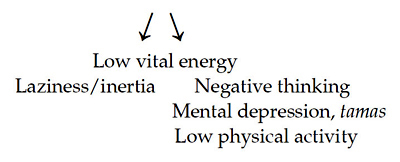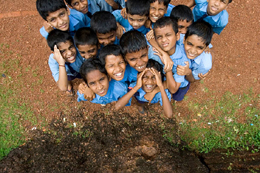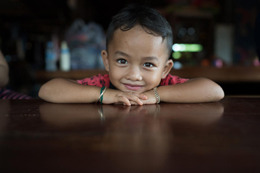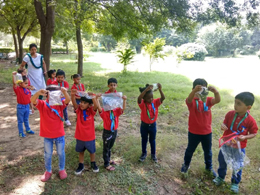Reflections
Reflections on vital education
Abstract
The vital is a crucial aspect of the being and usually governs all our actions, which in turn shape our character and thus, our destiny. Strengthening the vital should be an important aspect of a child’s education. Being caught up in the development of the mental faculty, this aspect of vital education has not traditionally been incorporated in children’s education. This article tries to bring to the forefront some of the practical ways in which we can work on the vital in children. It is an attempt to help parents and caregivers understand the vital in a simpler way.
What is the vital?
“It [vital] means prana – it is the life-force and desire-force in a man and the part of the being that responds to desire and is the instrument of the life-forces (1).”
The vital is the life-force, the energy behind the desires and will of an individual. The vital in a human being stems from his impulses, feelings and emotions. Thus, educating the vital is actually educating the emotions and impulses in you.
How are the vital, physical and mental parts interrelated?
A low vital energy can affect all the aspects of our being, namely the physical and mental and it impedes the influence of the psychic being. This can be understood with the simple line diagram below:

Laziness and mental depression are born as a result of a low vital that disconnects us from our core, leading to states of lower consciousness (moving us away from the psychic being).
Thus, we can see that uplifting the vital can actually transform the physical as well as the mental aspects of a being and help him/her to achieve a higher level of consciousness.
In children, these emotions and feelings are a result of their sensory perceptions in the initial years. As they grow, the thoughts and emotions which arise as a result of these sensory experiences are responsible for shaping their character.
Therefore, as the Mother has said that, “This vital education has two principal aspects, very different in their aims and methods, but both equally important. The first concerns the development and use of the sense organs. The second the progressing awareness and control of the character, culminating in its transformation (2).”
Children with a higher and lower vital
A child with a higher vital will have a desire for progress and a strong will to move forward in life. On the other hand, a child with low vital energies will have a weak will-power, low attention-span and a lack of perseverance in carrying out tasks to completion. As a result of the low vital energies, the child may suffer from low self-esteem and will be preoccupied with fear, anger and laziness.
Thus, incorporating a vital education into the curriculum makes them become more aware of their thoughts, emotions and actions and thus transforms their consciousness to a higher level. This fulfils the main aim of education: rising to a higher level of consciousness.
Practical ways to strengthen the vital
In the process of understanding my own vital, I have realised its importance in the education of a child. Some practical ways of educating the senses in children, so as to develop a stronger vital, are:
1. Daily physical exercise
Physical exercise, preferably at the beginning of the day, can help to strengthen the vital in a child. Physical education is the starting-point of strengthening the vital of a child, as it helps in increasing his or her will-power and perseverance. Along with this, it provides the enthusiasm and the positive energy which the child needs daily to perform his tasks.
2. Regular nature walks
Nature walks expose children to the beauty and harmony of nature. The beauty in nature, even something as simple as the beauty of flowers, fill the heart with a certain feeling of wonder and love for the surroundings, which is a positive emotion, having a positive impact on our vital.
Natural surroundings either with trees, water-bodies or hills and mountains also inculcate within us a sense of deep serenity and peace, which again have a positive impact on the vital.
Nature also includes birds, animals and little creatures which often go unnoticed in our day-to-day life. On coming into contact with these creatures, children can develop a sense of compassion and empathy. These traits if developed at a young age can go a long way in the formation of a loving individual.
3. Art and music
Art and music play a great role in the refinement of the senses of a child. As adults, we have experienced that art and music can naturally relax our mind and connect us with our innermost core (soul/psychic).
In their younger years, especially from 3 to 6 years of age, children are ‘natural artists’. They can express themselves more through art than through reading and writing.
Incorporating art in the curriculum right from a younger age helps a child to express his observations and emotions in a more colourful and creative way and also makes his learning-process more interesting and enjoyable. Exposing a child to beautiful art-forms and melodious music can inculcate within him or her a deep sense of harmony and peace.
“A methodical and enlightened cultivation of the senses can, little by little, eliminate from the child whatever is by contagion vulgar, commonplace and crude. This education will have very happy effects even on his character. For one who has developed a truly refined taste will, because of this very refinement, feel incapable of acting in a crude, brutal or vulgar manner (3).”
4. Pleasant home atmosphere
Apart from this, a simple practice followed by parents of making their homes a beautiful place, can also instill a child’s mind with beauty and harmony. Making homes beautiful, does not imply filling them with costly show-pieces, but rather it implies incorporating the beauty of nature with plants and flowers and keeping the place well organised)
The second part of vital education is the transformation of character. This especially applies to children between the ages of 8 -18 years.
Till today moral education has become a part of the curriculum in schools, but unfortunately it has not been able to impart a strong character to the students.
Why is this so? The Mother has said that a child cannot learn by merely preaching/teaching a certain value, but parents and educators have to be a living example in order to inculcate the value in the child.
The child, by experiencing the positive impact of these values from his surrounding fellow beings will naturally imbibe them without any effort.
Reflections
Another way of working with these values is to incorporate ‘reflections’ as a part of the daily curriculum of the children in this age-group.
In simple words, reflecting their thoughts on a simple story or drama or even a small event in their classroom, can help children to draw important life lessons.
Also, movies and songs can be used by teachers and parents as a means to initiate discussion with the children. This method has proven to be an interesting and exciting way of learning for students.
Thus, incorporating vital education in the curriculum can go a long way in building emotionally intelligent children and thus creating a stronger and happier society.
References
1. Sri Aurobindo. The Complete Works of Sri Aurobindo. Volume 28. Pondicherry: Sri Aurobindo Ashram Trust; 2012, p. 185.
2. The Mother. The Collected Works of the Mother, Volume 12. 2nd ed. Pondicherry. Sri Aurobindo Ashram Trust; 1999, p. 20.3. Ibid., p. 21.
Acknowledgment
My heartfelt gratitude to Mirambika — Free Progress School, New Delhi, for helping me understand the importance of vital education.
Dr. Monika Nanda is a surgeon and mother practising Integral Yoga based in Pondicherry
Share with us (Comments,contributions,opinions)
When reproducing this feature, please credit NAMAH,and give the byline. Please send us cuttings.





